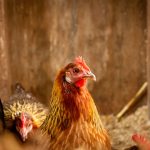Maintaining warm feet for chickens during winter is essential for their health and welfare. Chickens are prone to frostbite, particularly on their combs, wattles, and feet, where feathers are absent. Frostbite occurs when tissue freezes, potentially causing damage or, in extreme cases, necessitating amputation.
Preventing frostbite by keeping chickens’ feet warm ensures their health and comfort throughout cold winter periods. Warm feet also contribute to overall body temperature regulation in chickens. Their feet contain numerous blood vessels that help dissipate excess heat in summer and conserve heat in winter.
By keeping their feet warm, chickens can maintain a stable body temperature, which is crucial for their health and productivity. Understanding and addressing the need for warm feet in winter is a fundamental aspect of responsible chicken husbandry and flock management.
Table of Contents
- 1 Providing Adequate Shelter and Bedding for Chickens
- 2 Using Insulation and Heating Methods in the Coop
- 3 Implementing Proper Nutrition and Hydration for Chickens
- 4 Utilizing Protective Gear for Chicken Feet
- 5 Monitoring and Adjusting for Changes in Weather
- 6 Consulting with a Veterinarian for Additional Advice and Support
- 7 FAQs
- 7.1 What are some ways to keep chickens’ feet warm in winter?
- 7.2 Why is it important to keep chickens’ feet warm in winter?
- 7.3 What are some signs that a chicken’s feet are too cold?
- 7.4 Are there any specific breeds of chickens that are more susceptible to cold feet?
- 7.5 Can I use heat lamps to keep chickens’ feet warm in winter?
Key Takeaways
- Keeping chicken feet warm in winter is important for their overall health and well-being
- Providing adequate shelter and bedding is crucial for protecting chickens from the cold
- Using insulation and heating methods in the coop can help maintain a comfortable temperature for the chickens
- Proper nutrition and hydration are essential for keeping chickens healthy during the winter months
- Utilizing protective gear for chicken feet, such as boots or socks, can prevent frostbite and injury
Providing Adequate Shelter and Bedding for Chickens
Providing Adequate Shelter and Bedding for Your Chickens
Insulating the Coop
A well-insulated coop with proper ventilation is essential for keeping your chickens warm and dry during the cold winter months. Make sure that the coop is free from drafts and leaks, as these can contribute to cold and damp conditions that can lead to frostbite and other health issues.
Bedding and Comfort
Providing plenty of clean and dry bedding, such as straw or wood shavings, will help to insulate the coop and provide a comfortable environment for your chickens. It’s also important to ensure that the coop is spacious enough to accommodate your entire flock without overcrowding, as overcrowding can lead to increased moisture and ammonia levels, which can contribute to cold and damp conditions.
Roosts and Foot Care
Providing roosts for your chickens to perch on will also help to keep their feet off the cold ground and prevent frostbite.
Overall Importance
Overall, providing adequate shelter and bedding for your chickens is essential for keeping their feet warm and ensuring their overall comfort and well-being during the winter months.
Using Insulation and Heating Methods in the Coop

In addition to providing adequate shelter and bedding, using insulation and heating methods in the coop can help to keep your chickens’ feet warm in winter. Insulating the coop with materials such as foam board or fiberglass insulation can help to retain heat and prevent drafts, creating a more comfortable environment for your flock. Additionally, using a heat lamp or radiant heater can provide supplemental warmth during particularly cold periods, helping to keep your chickens’ feet warm and prevent frostbite.
It’s important to use caution when using heating methods in the coop, as improper use can pose fire hazards and increase the risk of carbon monoxide poisoning. Make sure to follow manufacturer’s instructions and use heating devices that are specifically designed for use in poultry coops. Monitoring the temperature in the coop with a thermometer can help you ensure that it remains within a safe range for your chickens.
Overall, using insulation and heating methods in the coop can help to keep your chickens’ feet warm and prevent frostbite during the winter months.
Implementing Proper Nutrition and Hydration for Chickens
Proper nutrition and hydration are essential for keeping chicken feet warm in winter. Providing a balanced diet that meets your chickens’ nutritional needs will help to support their overall health and immune function, making them more resilient to cold weather conditions. In particular, providing high-quality protein and energy sources, such as poultry feed supplemented with grains and seeds, can help to support their metabolic processes and maintain body temperature.
In addition to proper nutrition, ensuring that your chickens have access to clean and unfrozen water is essential for their hydration and overall well-being during the winter months. Using heated waterers or regularly replacing frozen water with fresh water will help to prevent dehydration and ensure that your chickens remain healthy and hydrated. Overall, implementing proper nutrition and hydration for your chickens is essential for keeping their feet warm and ensuring their overall health during the winter months.
Utilizing Protective Gear for Chicken Feet
Utilizing protective gear for chicken feet can help to keep them warm and prevent frostbite during the winter months. One option is to use chicken saddles or aprons, which are protective garments that cover the back and wings of chickens, providing an extra layer of insulation and protection from cold and damp conditions. Additionally, using chicken boots or leg wraps can help to keep their feet warm and dry, reducing the risk of frostbite.
When using protective gear for chicken feet, it’s important to ensure that it fits properly and does not restrict their movement or cause discomfort. Regularly checking the fit and condition of the gear will help to ensure that it remains effective in keeping their feet warm and protected. Overall, utilizing protective gear for chicken feet can help to prevent frostbite and ensure the well-being of your flock during the winter months.
Monitoring and Adjusting for Changes in Weather

Anticipating Weather Changes
Monitoring the weather conditions and adjusting your management practices accordingly is essential for keeping chicken feet warm in winter. Paying attention to weather forecasts and temperature fluctuations will help you anticipate changes in weather conditions and take proactive measures to keep your chickens comfortable and safe. For example, if a cold snap is forecasted, you can increase insulation in the coop or provide additional heating to keep their feet warm.
Regular Flock Checks
Regularly checking on your flock throughout the day will also help you monitor their comfort level and make adjustments as needed. Observing their behavior, such as huddling together for warmth or showing signs of distress, can provide valuable insight into their well-being and help you identify any issues that need attention.
Ensuring Overall Health and Comfort
Overall, monitoring and adjusting for changes in weather is essential for keeping chicken feet warm and ensuring the overall health and comfort of your flock during the winter months. By staying vigilant and taking proactive measures, you can help keep your chickens happy, healthy, and warm throughout the cold winter season.
Consulting with a Veterinarian for Additional Advice and Support
Consulting with a veterinarian who specializes in poultry health can provide you with additional advice and support for keeping chicken feet warm in winter. A veterinarian can help you assess the specific needs of your flock based on factors such as breed, age, and overall health status, and provide tailored recommendations for managing their comfort during the winter months. Additionally, a veterinarian can provide guidance on identifying early signs of frostbite or other health issues in your flock, as well as treatment options if needed.
In addition to seeking professional advice, joining online forums or local poultry groups can provide you with valuable insights from experienced chicken keepers who have dealt with similar challenges. Sharing experiences and learning from others can help you refine your management practices and ensure the well-being of your flock during the winter months. Overall, consulting with a veterinarian for additional advice and support can help you make informed decisions about keeping chicken feet warm in winter and ensure the overall health and comfort of your flock.
In conclusion, keeping chicken feet warm in winter is essential for preventing frostbite and ensuring the overall health and well-being of your flock. By providing adequate shelter and bedding, using insulation and heating methods in the coop, implementing proper nutrition and hydration, utilizing protective gear, monitoring weather changes, and consulting with a veterinarian for additional advice and support, you can create a comfortable environment for your chickens during the cold winter months. Taking proactive measures to keep their feet warm will help you maintain a healthy and productive flock that thrives year-round.
If you’re looking for more tips on keeping your chickens comfortable in the winter, check out this article on creating a cozy chicken coop. It offers advice on providing warmth and comfort for your feathered friends during the colder months.
FAQs
What are some ways to keep chickens’ feet warm in winter?
Some ways to keep chickens’ feet warm in winter include providing a dry and insulated coop, using deep litter bedding, and using heating pads or heated perches.
Why is it important to keep chickens’ feet warm in winter?
It is important to keep chickens’ feet warm in winter to prevent frostbite and other cold-related injuries. Cold feet can lead to discomfort and health issues for the chickens.
What are some signs that a chicken’s feet are too cold?
Signs that a chicken’s feet are too cold include discoloration, swelling, or a lack of movement. If you notice any of these signs, it’s important to take steps to warm up the chicken’s feet.
Are there any specific breeds of chickens that are more susceptible to cold feet?
Yes, some breeds of chickens are more susceptible to cold feet, such as those with feathered feet or smaller, lighter breeds. It’s important to take extra precautions to keep these chickens’ feet warm in winter.
Can I use heat lamps to keep chickens’ feet warm in winter?
While heat lamps can be used to provide warmth in the coop, they should be used with caution to prevent fire hazards and burns. It’s important to follow safety guidelines and consider alternative methods such as heated perches or heating pads.

Meet Walter, the feathered-friend fanatic of Florida! Nestled in the sunshine state, Walter struts through life with his feathered companions, clucking his way to happiness. With a coop that’s fancier than a five-star hotel, he’s the Don Juan of the chicken world. When he’s not teaching his hens to do the cha-cha, you’ll find him in a heated debate with his prized rooster, Sir Clucks-a-Lot. Walter’s poultry passion is no yolk; he’s the sunny-side-up guy you never knew you needed in your flock of friends!


Meet Walter, the feathered-friend fanatic of Florida! Nestled in the sunshine state, Walter struts through life with his feathered companions, clucking his way to happiness. With a coop that’s fancier than a five-star hotel, he’s the Don Juan of the chicken world. When he’s not teaching his hens to do the cha-cha, you’ll find him in a heated debate with his prized rooster, Sir Clucks-a-Lot. Walter’s poultry passion is no yolk; he’s the sunny-side-up guy you never knew you needed in your flock of friends!







